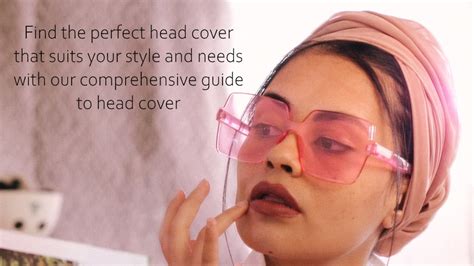Introduction
Head coverings have played a significant role in women’s fashion and cultural practices for centuries. From religious mandates to fashion statements, they have evolved to meet the diverse needs and preferences of women worldwide. In this article, we delve deeper into the world of head coverings, exploring their history, types, cultural significance, benefits, and future trends.

Types of Head Coverings
Head coverings come in a wide variety, catering to different styles, religious beliefs, and cultural traditions. Here are some common types:
- Hijab: A scarf or headscarf worn by Muslim women to cover their hair and neck, following religious precepts.
- Burqa: A full-body covering with a mesh or grille for vision, worn by some Muslim women in certain regions.
- Niqab: A face veil that covers the lower part of the face, leaving only the eyes exposed.
- Mantilla: A lace or silk veil worn by Catholic women during Mass or other religious ceremonies.
- Turban: A head wrap made of fabric, typically worn by Sikh women or in fashion contexts.
- Hat: A brimmed or crown-shaped covering worn for sun protection, fashion, or religious purposes.
- Yarmulke: A skullcap worn by Jewish men to cover their heads while praying or studying religious texts.
Cultural Significance
Head coverings hold immense cultural significance in many societies. For some religious traditions, such as Islam and Sikhism, they are mandatory for women and symbolize modesty, privacy, and obedience. In cultural contexts, head coverings may convey social status, marital status, or ethnic identity.
Benefits of Head Coverings
Beyond their cultural and religious significance, head coverings also offer several practical benefits:
- Sun protection: Wide-brimmed hats and turbans shield the face and scalp from harmful UV rays, reducing the risk of sunburn and skin cancer.
- Warmth: Head coverings made of insulating materials, such as wool or fleece, provide warmth during cold weather.
- Modesty: For some women, head coverings represent a form of modesty and privacy, allowing them to feel more comfortable in public spaces.
- Hair protection: Head coverings can protect hair from environmental damage, such as pollution, dryness, and styling products.
Future Trends
The world of head coverings is constantly evolving, with new designs and trends emerging. Here are some potential future directions:
- Sustainability: Head coverings made from recycled or sustainable materials are becoming increasingly popular as consumers seek eco-friendly options.
- Fashionable functionality: Head coverings that combine fashion with functionality, such as hats with built-in sun protection or turbans with stylish patterns, are gaining traction.
- Personalized designs: Customization and personalization of head coverings are on the rise, allowing women to express their unique style and identity.
Informative Tables
Table 1: Types of Head Coverings
| Type | Description |
|---|---|
| Hijab | Covering worn by Muslim women to cover hair and neck |
| Burqa | Full-body covering with mesh or grille for vision |
| Niqab | Face veil that covers lower part of face |
| Mantilla | Lace or silk veil worn by Catholic women |
| Turban | Head wrap made of fabric, typically worn by Sikh women |
| Hat | Brimmed or crown-shaped covering for sun protection, fashion, or religious purposes |
| Yarmulke | Skullcap worn by Jewish men while praying or studying religious texts |
Table 2: Cultural Significance of Head Coverings
| Country | Religion/Culture | Type |
|---|---|---|
| Saudi Arabia | Islam | Hijab, Burqa, Niqab |
| India | Sikhism | Turban |
| Spain | Catholicism | Mantilla |
| United States | Fashion | Hat, Turban |
| Israel | Judaism | Yarmulke |
Table 3: Benefits of Head Coverings
| Benefit | Type |
|---|---|
| Sun protection | Wide-brimmed hats, turbans |
| Warmth | Head coverings made of insulating materials |
| Modesty | Hijab, Burqa, Niqab |
| Hair protection | Head coverings made of protective fabrics |
Table 4: Future Trends in Head Coverings
| Trend | Description |
|---|---|
| Sustainability | Head coverings made from recycled or sustainable materials |
| Fashionable functionality | Head coverings that combine fashion with functionality |
| Personalized designs | Customization and personalization of head coverings |
Effective Strategies
Women who wish to explore the world of head coverings can consider the following effective strategies:
- Research: Acquaint yourself with the different types of head coverings, their cultural significance, and how to wear them properly.
- Experiment: Try different styles and fabrics to find what suits you best and complements your lifestyle.
- Accessorize: Head coverings can be adorned with accessories, such as pins, scarves, or jewelry, to create a unique and personal look.
- Be confident: Wear your head covering with confidence and conviction. It is a reflection of your personal style and values.
FAQs
1. What are the different types of head coverings for women?
– Hijab, Burqa, Niqab, Mantilla, Turban, Hat, Yarmulke
2. Why do some women wear head coverings?
– Religious mandates, cultural traditions, modesty, sun protection, warmth
3. What are the benefits of head coverings?
– Sun protection, warmth, modesty, hair protection
4. How do I choose the right head covering for me?
– Consider your personal style, religious beliefs, and cultural context
5. What are some creative ideas for wearing head coverings?
– Experiment with different fabrics, patterns, and accessories
6. How can I wear a head covering with confidence?
– Choose a style that makes you feel comfortable and empowered
7. What is the future of head coverings?
– Sustainable materials, fashionable functionality, personalized designs
8. Where can I find more information about head coverings?
– Religious organizations, cultural groups, fashion magazines, online resources
